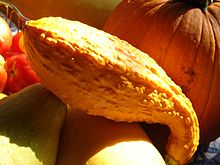| Cucurbita pepo 'Yellow crookneck' | |
|---|---|
 Crookneck squash along with other types of squash | |
| Species | Cucurbita pepo |
| Cultivar | Yellow crookneck |
| Origin | Eastern North America |
| Nutritional value per 100 g (3.5 oz) | |||||||||||||||||||
|---|---|---|---|---|---|---|---|---|---|---|---|---|---|---|---|---|---|---|---|
| Energy | 19 kcal (79 kJ) | ||||||||||||||||||
3.9 g | |||||||||||||||||||
| Dietary fiber | 1.0 g | ||||||||||||||||||
0.3 g | |||||||||||||||||||
1.0 g | |||||||||||||||||||
| |||||||||||||||||||
| Other constituents | Quantity | ||||||||||||||||||
| Water | 94 g | ||||||||||||||||||
| †Percentages estimated using US recommendations for adults,[1] except for potassium, which is estimated based on expert recommendation from the National Academies.[2] | |||||||||||||||||||
Crookneck squash, also known as yellow squash, is a cultivar of Cucurbita pepo,[3] the species that also includes some pumpkins and most other summer squashes. The plants are bushy[3] and do not spread like the plants of winter squash and pumpkin.[4] Most often used as a summer squash, it is characterized by its yellow skin (which may be smooth or bumpy)[4] and sweet yellow flesh, as well as its distinctive curved stem-end or "crooked neck".[5] It should not be confused with crookneck cultivars of Cucurbita moschata, such as the winter squash 'Golden Cushaw',[6] or the vining summer squash 'Tromboncino'.[3] Its name distinguishes it from another similar-looking variety of C. pepo, the straightneck squash, which is also usually yellow.[7][8][9] There is one similar non-edible C. pepo variety: C. pepo var. ovifera.[10]
Yellow crookneck squash are generally harvested immature, when they are less than two inches in diameter,[4][5] since the skin toughens and the quality degrades as the squash reaches full maturity.[11]
- ^ United States Food and Drug Administration (2024). "Daily Value on the Nutrition and Supplement Facts Labels". FDA. Archived from the original on 2024-03-27. Retrieved 2024-03-28.
- ^ National Academies of Sciences, Engineering, and Medicine; Health and Medicine Division; Food and Nutrition Board; Committee to Review the Dietary Reference Intakes for Sodium and Potassium (2019). Oria, Maria; Harrison, Meghan; Stallings, Virginia A. (eds.). Dietary Reference Intakes for Sodium and Potassium. The National Academies Collection: Reports funded by National Institutes of Health. Washington, DC: National Academies Press (US). ISBN 978-0-309-48834-1. PMID 30844154. Archived from the original on 2024-05-09. Retrieved 2024-06-21.
- ^ a b c "Zucchetta". Mount Vernon Northwestern Washington Research and Extension Center: Vegetable Research and Extension. Washington State University. Retrieved 10 May 2013.
- ^ a b c "Summer Squash". Watch Your Garden Grow. University of Illinois Extension. Retrieved 14 May 2013.
- ^ a b "Summer Squash" (PDF). University of the District of Columbia Cooperative Extension Service. Retrieved 14 May 2013.
- ^ Phillips, R.; Rix, M. (1993). Vegetables. New York: Random House.
- ^ Saade, R. Lira; Hernández, S. Montes. "Cucurbits". Purdue Horticulture. Retrieved September 2, 2013.
- ^ "Cucurbita pepo". Missouri Botanical Garden. Retrieved September 2, 2013.
- ^ Heistinger, Andrea (2013). The Manual of Seed Saving: Harvesting, Storing, and Sowing Techniques for Vegetables, Herbs, and Fruits. Portland, OR: Timber Press. p. 278. ISBN 978-1-60469-382-9.
- ^ Decker, Deena S.; Wilson, Hugh D. (1987). "Allozyme Variation in the Cucurbita pepo Complex: C. pepo var. ovifera vs. C. texana". Systematic Botany. 12 (2). American Society of Plant Taxonomists: 263–273. doi:10.2307/2419320. JSTOR 2419320.
- ^ "Summer and Winter Squash". Utah State University Cooperative Extension. Archived from the original on 10 June 2013. Retrieved 14 May 2013.